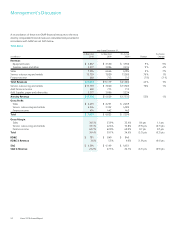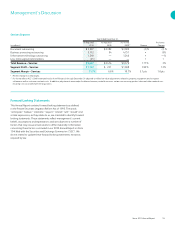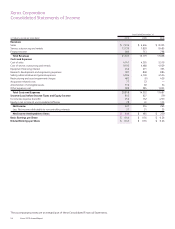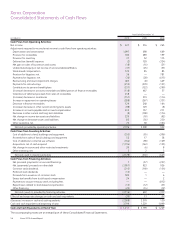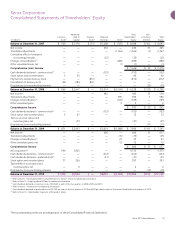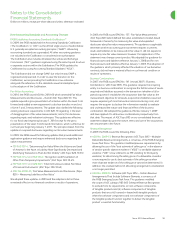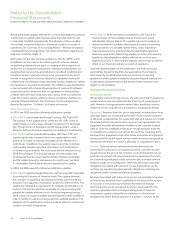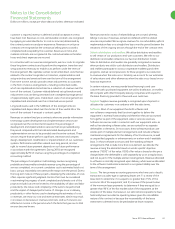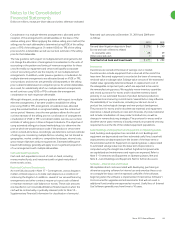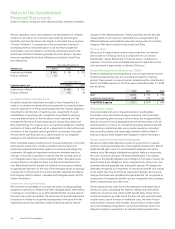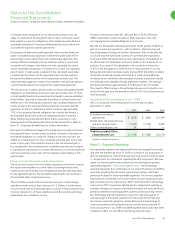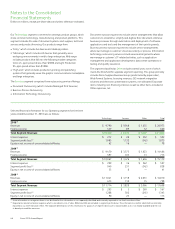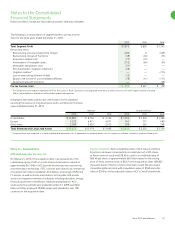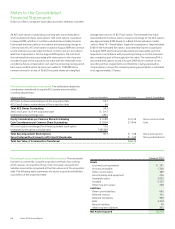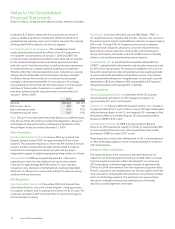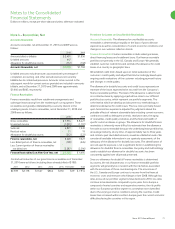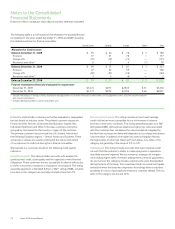Xerox 2010 Annual Report Download - page 64
Download and view the complete annual report
Please find page 64 of the 2010 Xerox annual report below. You can navigate through the pages in the report by either clicking on the pages listed below, or by using the keyword search tool below to find specific information within the annual report.Notes to the Consolidated
Financial Statements
Dollars in millions, except per-share data and unless otherwise indicated.
62 Xerox 2010 Annual Report
Contingent payments, if any, are recognized as revenue in the period
when the customer exceeds the minimum copy volumes specified in
the contract. Revenues under bundled arrangements are allocated
considering the relative selling prices of the lease and non-lease
deliverables included in the bundled arrangement. Lease deliverables
include maintenance and executory costs, equipment and financing,
while non-lease deliverables generally consist of the supplies and non-
maintenance services. The allocation for the lease deliverables begins
by allocating revenues to the maintenance and executory costs plus
profit thereon. These elements are generally recognized over the term
of the lease as service revenue. The remaining amounts are allocated
to the equipment and financing elements which are subjected to the
accounting estimates noted above under “Leases.”
Multiple Element Arrangements: We enter into the following revenue
arrangements that may consist of multiple deliverables:
Bundled lease arrangements, which typically include both lease
•
deliverables and non-lease deliverables as described above.
Sales of equipment with a related full-service maintenance agreement.
•
Contracts for multiple types of outsourcing services, as well as
•
professional and value-added services. For instance, we may contract
for an implementation or development project and also provide
services to operate the system over a period of time; or we may
contract to scan, manage and store customer documents.
If a deliverable in a multiple-element arrangement is subject to specific
guidance, such as leased equipment in our bundled lease arrangements
(which is subject to specific leasing guidance) or accessory software
(which is subject to software revenue recognition guidance), that
deliverable is separated from the arrangement based on its relative
selling price (the relative selling price method – see below) and
accounted for in accordance with such specific guidance. The remaining
deliverables in a multiple-element arrangement are accounted for based
on the following guidance.
A multiple-element arrangement is separated into more than one unit
of accounting if both of the following criteria are met:
The delivered item(s) has value to the customer on a stand-alone
•
basis; and
If the arrangement includes a general right of return relative to
•
the delivered item(s), delivery or performance of the undelivered
item(s) is considered probable and substantially in our control. If
these criteria are not met, the arrangement is accounted for as one
unit of accounting and the recognition of revenue is generally upon
delivery/completion or ratably as a single unit of accounting over the
contractual service period.
For purposes of determining the economic life, we consider the
most objective measure to be the original contract term, since most
equipment is returned by lessees at or near the end of the contracted
term. The economic life of most of our products is five years, since this
represents the most frequent contractual lease term for our principal
products and only a small percentage of our leases have original terms
longer than five years. We continually evaluate the economic life of
both existing and newly introduced products for purposes of this
determination. Residual values, if any, are established at lease inception
using estimates of fair value at the end of the lease term.
The vast majority of our leases that qualify as sales-type are non-
cancelable and include cancellation penalties approximately equal
to the full value of the lease receivables. A portion of our business
involves sales to governmental units. Governmental units are those
entities that have statutorily defined funding or annual budgets that
are determined by their legislative bodies. Certain of our governmental
contracts may have cancellation provisions or renewal clauses that are
required by law, such as 1) those dependant on fiscal funding outside
of a governmental unit’s control; 2) those that can be cancelled if
deemed in the best interest of the governmental unit’s taxpayers; or
3) those that must be renewed each fiscal year, given limitations that
may exist on entering into multi-year contracts that are imposed by
statute. In these circumstances, we carefully evaluate these contracts
to assess whether cancellation is remote. The evaluation of a lease
agreement with a renewal option includes an assessment as to whether
the renewal is reasonably assured based on the apparent intent and
our experience of such governmental unit. We further ensure that the
contract provisions described above are offered only in instances where
required by law. Where such contract terms are not legally required, we
consider the arrangement to be cancelable and account for the lease
as an operating lease.
After the initial lease of equipment to our customers, we may enter
subsequent transactions with the same customer whereby we extend
the term. Revenue from such lease extensions is typically recognized over
the extension period.
Bundled Lease Arrangements: We sell our products and services under
bundled lease arrangements, which typically include equipment, service,
supplies and financing components for which the customer pays a single
negotiated fixed minimum monthly payment for all elements over the
contractual lease term. Approximately 40% of our equipment sales
revenue is related to sales made under bundled lease arrangements.
These arrangements also typically include an incremental, variable
component for page volumes in excess of contractual page volume
minimums, which are often expressed in terms of price-per-page.
The fixed minimum monthly payments are multiplied by the number
of months in the contract term to arrive at the total fixed minimum
payments that the customer is obligated to make (“fixed payments”)
over the lease term. The payments associated with page volumes
in excess of the minimums are contingent on whether or not such
minimums are exceeded (“contingent payments”). In applying our
lease accounting methodology, we only consider the fixed payments for
purposes of allocating to the relative fair value elements of the contract.


